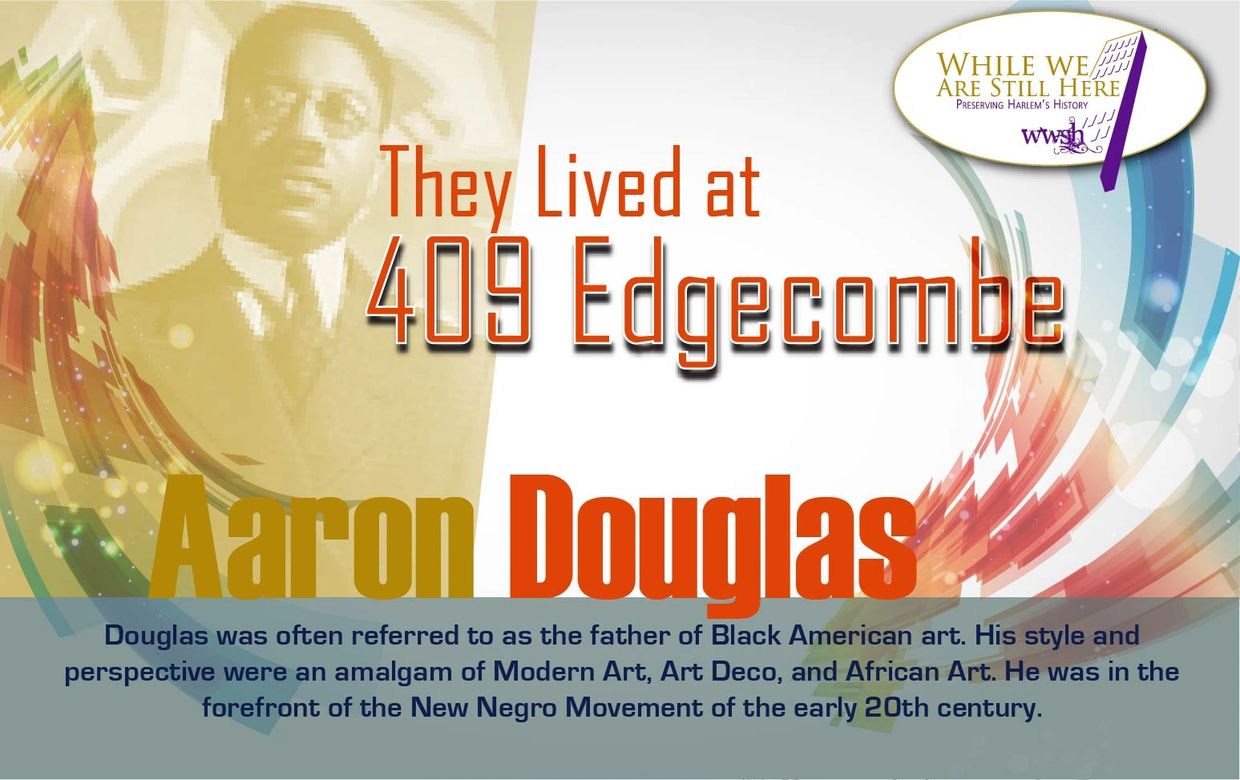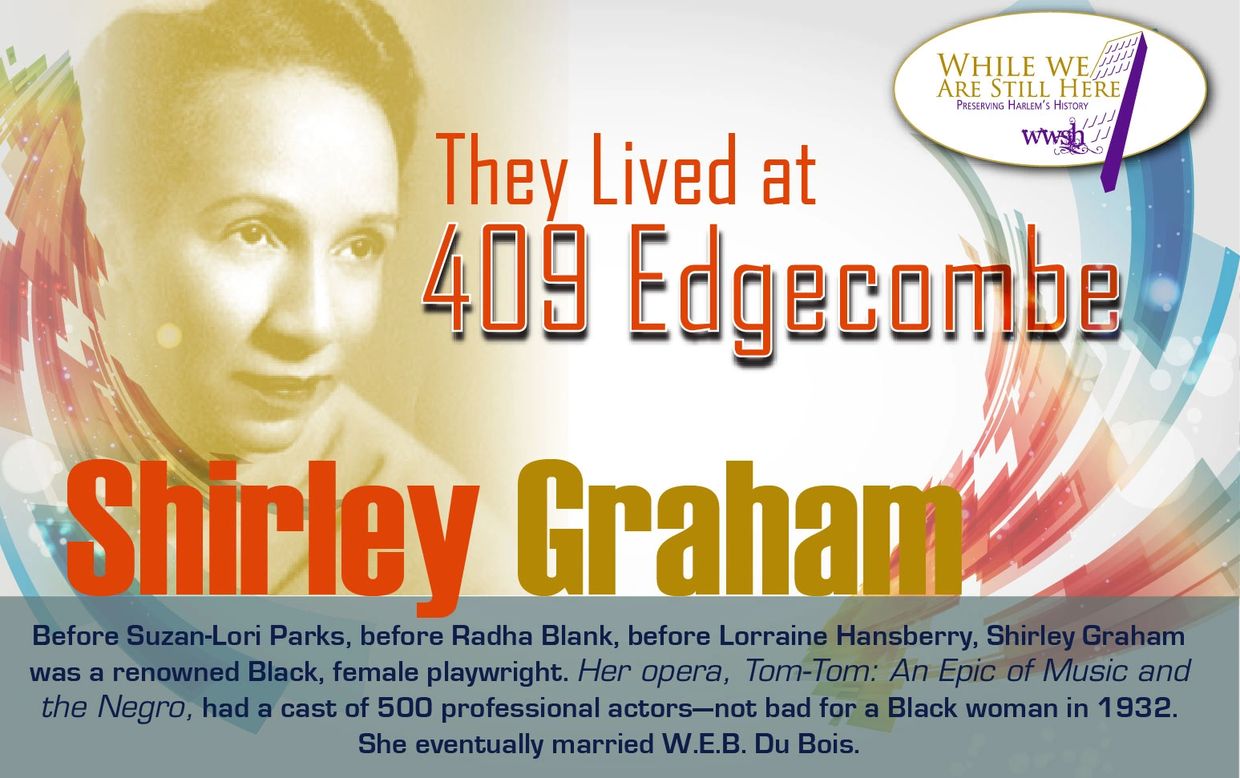
Katherine Butler-Jones
Educator, playwright, and author Butler Jones grew up at 409 Edgecombe Avenue. Judging by her literary output and the oral history she shared with While We Are Still Here, the people in that building helped shape her creativity. She described 409 as a socio-economically mixed residence where one could find “doctors, lawyers, a number runner, hot goods, and a hairdresser." Butler Jones transformed her early experiences into a play called 409 Edgecombe Avenue: The House On Sugar Hill. She also wrote an essay in Herb Boyd’s Harlem Reader about Madam Stephanie St. Clair, the numbers queen of Harlem, who also lived at 409. Of Butler Jones’s memoir, Deeper Roots: An American Odyssey, Boyd stated, “…How wonderful to relive these splendid moments with a superb storyteller."

AARON DOUGLAS
Because of the illustrations he created for philosopher Alain Locke’s influential work, The New Negro, Aaron Douglas was the visual artist of choice for many African American authors and publications. Douglas’s work shows his full embrace of Locke’s conception that Black artists should look to Africa for artistic inspiration.
Through his artwork that graced the pages of works that include James Weldon Johnson’s God’s Trombones and Fire!, a journal edited by Langston Hughes, Zora Neale Hurston, and Wallace Thurman, and through the body of his work as an illustrator, graphic designer, and muralist, Douglas was dubbed “the father of Black Art.”
Aaron Douglas: African-American painter (1898-1979)
Aaron Douglas (May 26, 1898 February 3, 1979) was an African American painter and a major figure in the Harlem Renaissance.

W.E.B. DU BOIS
W.E.B. Du Bois was a Pan-Africanist, scholar, sociologist, activist, editor, poet, and playwright who, along with librarian Regina Andrews, founded the KRIGWA Players in Harlem during the Renaissance era. Housed in the basement of the 135th Street Branch of the New York Public Library, KRIGWA sought to produce plays written and acted by Black people.
W.E.B. DuBois speaks, "The Atlanta Years"
W.E.B. DuBois talks about his time in Atlanta, from the collection Our Souls Have Grown Deep Like The Rivers. He recalls a specific lynching in Atlanta

Shirley Graham Du Bois
Shirley Graham Du Bois was a woman of many talents. In addition to composing Tom-Tom: An Epic of Music and the Negro, the musical covering the expanse of Black music, as of the 1930s, she was an author who penned biographies of Phillis Wheatley, Paul Robeson, Kwame Nkrumah, among others.
Her politics were decidedly Left, and she was a member of the Communist Party USA for many years. Additionally, she was a confidant of President Kwame Nkrumah and another African head of state, Julius Nyerere, of Tanzania. Shirley Graham spent most of her life fighting against racial and capitalist injustice. She was a staunch supporter of the Chinese Revolution, and China's leadership respected her for her support. She is buried in China.
Shirley Graham Du Bois | Conversation
Listening To Tom-Tom by Shirley Graham Du Bois | Full Concert & Conversation
Shirley Graham Du Bois on Imperialists and Neocolonialism
Shirley Graham Du Bois on Imperialists and Neocolonialism

Safiya Henderson-Holmes
She was an assistant professor at the graduate Creative Writing Program at Syracuse University. Henderson-Holmes published two books of poetry, Daily Bread, and Madness and a Little Bit of Hope, which won the Poetry Society of America’s William Carlos Williams Award. A committed activist, she was devoted to realizing her internationalist perspectives. She worked with projects and organizations such as Art Against Apartheid, the National Council of American-Soviet Friendship, and MADRE. There are those among us, who remember that on Mother's Day, she took flower bouquets to her mother-sister-friends throughout New York City.

James Weldon Johnson
February 12, 2022, was the 122nd anniversary of the first public rendition of “Lift Ev’ry Voice and Sing.” The event happened in Jacksonville, Florida, the birthplace of James and his brother, J. Rosamond Johnson, who composed the music for the song. The very first performance of the song happened on February 12, 1900, by five hundred school children in Jacksonville to commemorate Abraham Lincoln’s birthday.
The United States House of Representatives declared “Lift Ev ’ry Voice and Sing” the national hymn of the United States.
Howard Gospel Choir - "Lift Every Voice and Sing"
The Howard Gospel Choir of Howard University sings "Lift Every Voice and Sing" (The Black National Anthem) at Jerusalemskirken (Church of Jerusalem) in Copenhagen, Denmark [Europe] as a part of our Northern Scandinavian Tour in February 2010.

marvel cooke
Upon coming to Harlem from Minneapolis, Marvel Cooke landed in the cultural vortex of the Renaissance era. She worked as W.E.B. Du Bois’s assistant at Crisis magazine. She made a name for herself as a journalist, labor organizer, and activist. Marvel Cooke was the first woman reporter at the Amsterdam News. Her circle of friends, comrades, and acquaintances included Richard Wright, Elizabeth Catlett, Countee Cullen, and Ella Baker, with whom she publicized the plight of Black domestic workers in an article, “The Bronx Slave Market.” In a foray into immersion journalism, Marvel went undercover as a domestic worker to deepen the previous expose. She, like Shirley Graham Du Bois, was active in the Communist Party. Marvel, like Louise Patterson Thompson, was active in the movement to free Angela Davis.
Marvel Cooke talks joining the CPUSA
Marvel Cooke (1903-2000) was an American journalist, writer, and civil rights activist. In 1928, she was the first woman reporter at the New York Amsterdam News and the first African-American woman to work at a mainstream white-owned newspaper. While working for Amsterdam News in the 1930s, Cooke helped create a local chapter of the Newspaper Guild, held union meetings in her home, and joined the Communist Party. She later went on to volunteer as national legal defense secretary for the Angela D

eunice carter, j.d.
Eunice Carter, J.D. was the first Black woman to graduate from Fordham Law School in 1932. She was the first African-American woman to work as a prosecutor in the New York County (Manhattan) District Attorney’s Office. Carter served as a key assistant to special prosecutor Thomas Dewey. She established crucial facts, which resulted in the successful prosecution of monster Charlie “Lucky” Luciano. She was active in the United Nations, the National Council of Negro Women, and the YWCA.

May Edward Chinn, m.d.
May Edward Chinn, M.D. was the first African American woman to graduate from the University and Bellevue Hospital Medical College who practiced medicine in Harlem for fifty years. Chinn was the piano accompanist to singer Paul Robeson. Her private practice was on Edgecombe Avenue, where she worked with other Black physicians at the Edgecombe Sanitarium for non-white patients. She advocated for early detection of cancer screening, including Pap smear tests for cervical cancer.
Copyright © 2025 While We re Still Here - All Rights Reserved.
Powered by EM Designs Group

Cookie Policy
This website uses cookies. By continuing to use this site, you accept our use of cookies.
